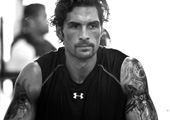Complex training, one of the most advanced forms of sports training, integrates strength training, plyometrics, and sport-specific movement. It consists of an intense strength (resistance) exercise followed by a plyometric exercise. Complex training is a great way to make sure that you are training more than just muscles with your workouts as it affects the nervous system. To capitalize on a muscle’s utmost potential to gain strength and speed, an athlete must raise the level of excitement in the muscle fibers and challenge them when they reach their highest levels. The first exercise is typically a resistance training exercise such as the hang clean, front squat or split jerk. Once the muscle fibers (motor neurons) are fired up through resistance training, it’s time to teach the muscles to function at their highest possible speeds. The second half of the workout will thus be a plyometric exercise such as the squat jump, box jump or skater hop. Plyometrics, also known as “jump training” or “plyos”, are exercises based around having muscles exert maximum force in as short a time as possible, with the goal of increasing both speed and power. It is best to choose a plyometric exercise that stimulates the muscles awakened during the resistance training exercise by performing a related or specific explosive movement similar to the resistance exercise. A simple example of this would be to do a front squat followed by a squat jump.
Once you understand the exercise components of complex training, you need to know how to apply it for maximum effectiveness. A major component of complex training is the theory of supercompensation. Supercompensation is the body’s ability to deal with stress, recover and then adapt to a new, higher level. If athletes are challenged with a plyometric exercise at the end of the recovery phase from the resistance exercise, they typically will respond with a level of performance even greater than previously possible. Below is a diagram that demonstrates supercompensation from Chu, D. Explosive Power & Strength. 1996.
Recovery after resistance training returns the nervous system back to a zero point, but because the body does not know the exact amount of energy necessary for the activity it is being exposed to, it continues past the zero level and into an area of hyper-stimulation that is called supercomensation. It is at this time that the plyometric activity will be most effective at stimulating the nervous system. This makes the amount of rest between the resistance exercise and plyometric activity crucial to maximizing performance gains. Also, the amount of rest between exercise pairing bouts is important so that the athlete can continue to train at maximal levels without letting the muscles cool down completely. For the www.HockeyOT.com program we use 30-60 seconds between exercise pairs and 1-3 minutes between paired exercise sets depending on the training goals and level of the athlete.
As you can see, designing the most effective training program is an intelligent balance of adequate levels of stimulation that allows the nervous system to maximally adapt and translate into improve athletic performance. Don’t leave all your hard work in the gym and on the track to chance. Use a scientifically formulated hockey specific program like www.HockeyOT.com to maximize your potential.
Dr. Chad Moreau is the President of HockeyOT.com, an online training site dedicated to improving the fitness level of hockey players of all levels. He was the former Strength & Conditioning/Nutrition Consultant for the Edmonton Oilers (NHL) and the Long Beach Ice Dogs (ECHL). For more information please visit hockeyot.com.















